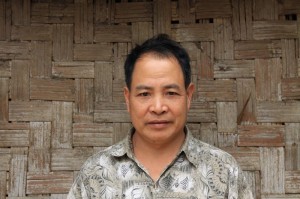Project Phongsali: Every Lao village has a village chief, or “naiban”.

The village naiban may be male or female, old or young. The naiban is always a good source of information about the makeup of the village.
Day 23
Every village in Laos has a village chief, or “naiban”. The position is not strictly reserved for an esteemed village elder but to be effective, the naiban, male or female, must be respected by people of the village. (Which is not to say that all naibans are virtuous; a very few are liars, drunks or scamps). The naiban is not necessarily a life-long resident of the village. Probably, the most important prerequisites for the job are sound literacy skills and the ability to mediate conflict among people.
Sop Houn‘s naiban is Mr. Khammon. He’s 45 years old and has been village chief for eight years. He’s a native of this district but not of this village. Still, this being a small place it probably didn’t take him long to learn all the essential village history and to forge friendships with respected village leaders. From the way in which people interact with him, it appears that he is well regarded.
Like every naiban I’ve ever met, Mr. Khammon keeps accurate records of events happening in the village. I have no doubt that if I thumbed through the “village book” for last year, I’d find a notation about a baldheaded American named “Mr. Jim” touring the village and discussing UXO with people.
Mr. Khammon maintains the village census both on paper and in his mind, and adjusts it immediately when a birth or death occurs. All marriages and divorces are registered with him and he stands ready to create a notarized paper trail formalizing any significant transaction that occurs within his domain.
Off the top of his head, Mr. Khammon shared these facts: the village has 96 houses, holding 150 families, with a total population of 528 people. There is an elementary school serving 127 students and, for the first time in village history, a secondary school. Since the secondary school is new, it now contains only the starting class consisting of 22 students. Each year for the next two years, a new class will be added until the school holds all three secondary grades.
In the past all secondary school enrollees from this village had to travel daily to Muang May, the district capital, to attend classes, a roundtrip distance of 24 kilometers. Some students boarded with families in that town in order to avoid the long, daily roundtrip. Others would cover the distance on motorcycle, or hitch a ride on a passing truck. The distance and inconvenience, not to mention expense, of attending school so far from home limited enrollment.
Sop Houn consists almost entirely of Tai Dam (Black Tai) people, a mid-mountain dwelling ethnic group that mostly lives in northeast Laos and northern Vietnam. (I’ve noticed that people in this village casually cross the border into Vietnam and that Vietnamese peddlers and scrap dealers frequently pass through the village drumming up business. (Actually, they don’t “drum”. They pull into town on a motorcycle loaded with goods to sell or with scrap they’ve collected. Then, they hook up a loudspeaker to the motorcycle’s battery and blast music through the village, alerting everyone to their arrival).
This village did not exist in this location during the war years. The area now occupied by the village was a substantial supply depot for the Phathet Lao, which would explain why so much airborne ordnance was dropped here. During the war civilians did their best to stay away from the fighting. They lived in small, isolated groups that didn’t have the complex social fabric that truly constitutes a community. Whenever bombing patterns changed and people no longer felt save where they were, they simply scooped up what they could carry and fled to a safer location.
Unlike the villages in Khammouan Province that I’ve come to know so well, the villages in May District have no nearby caves where people could shelter during bomb attacks. The old people here tell me that the best defense was to simply flee from danger; they avoided congregating in large groups for fear of being mistaken from the air for an enemy encampment. Thus, they lived for nine years. When the fighting ended disparate groups coalesced and founded Ban Sop Houn.
We’ve met several elderly civilian survivors of the bombing campaign. One fellow is missing a leg. A frail, elderly woman has just one eye. Several people have told us about relatives killed during the fighting, but so many years have passed and the life expectancy here is so short, that there are now few people around who experienced the war as adults. Of course, many middle-aged villagers have fragmentary, childhood memories of the war. But, as one man in his forties told me, “It was so long ago that I don’t know if I truly remember it. Or, is it perhaps my imagination?”
The loss of people who remember the war makes it harder for us to do our work. It’s the old people who remember where minefields were laid, where bombs were buried, where cluster bomblets were tossed to get them out from under foot. Without those leads, it’s all the more difficult for us to find and destroy ordnance before people happen upon it and get hurt.
